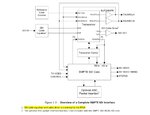beginner_EDA
Full Member level 4
To route data from one SDI Channel to another
Hi,
How to route SDI data coming on one channel as RX via MGT transceiver pin to another SDI Channel as TX also via MGT transceiver pin.
I am using following reference design:
https://www.xilinx.com/support/docu...s/xapp592-smpte-sdi-w-k7-gtx-transceivers.pdf
here data in (RX) and data out (TX) are on same channel (channel 0). I am using SDI Pass-Through mode.
But I would like to route data coming from one channel to another channel i.e. RX at channel 0 and TX at channel 1.
only providing corresponding MGT Transceiver pin didn't work. i.e. RX transceiver pin for channel 0 and TX trabsceiver pin for channel 1.
Any Idea?
Hi,
How to route SDI data coming on one channel as RX via MGT transceiver pin to another SDI Channel as TX also via MGT transceiver pin.
I am using following reference design:
https://www.xilinx.com/support/docu...s/xapp592-smpte-sdi-w-k7-gtx-transceivers.pdf
here data in (RX) and data out (TX) are on same channel (channel 0). I am using SDI Pass-Through mode.
But I would like to route data coming from one channel to another channel i.e. RX at channel 0 and TX at channel 1.
only providing corresponding MGT Transceiver pin didn't work. i.e. RX transceiver pin for channel 0 and TX trabsceiver pin for channel 1.
Any Idea?
